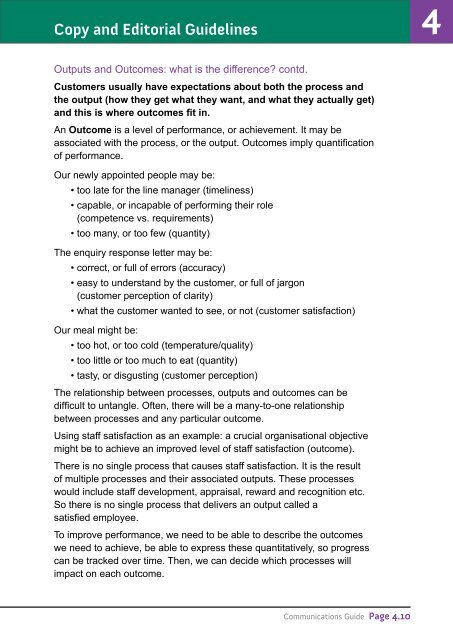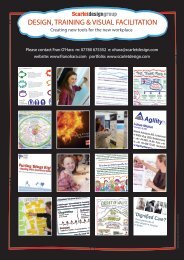Communications Guide - Fran O'hara
Communications Guide - Fran O'hara
Communications Guide - Fran O'hara
You also want an ePaper? Increase the reach of your titles
YUMPU automatically turns print PDFs into web optimized ePapers that Google loves.
Copy and Editorial <strong>Guide</strong>lines 4<br />
Outputs and Outcomes: what is the difference contd.<br />
Customers usually have expectations about both the process and<br />
the output (how they get what they want, and what they actually get)<br />
and this is where outcomes fit in.<br />
An Outcome is a level of performance, or achievement. It may be<br />
associated with the process, or the output. Outcomes imply quantification<br />
of performance.<br />
Our newly appointed people may be:<br />
• too late for the line manager (timeliness)<br />
• capable, or incapable of performing their role<br />
(competence vs. requirements)<br />
• too many, or too few (quantity)<br />
The enquiry response letter may be:<br />
• correct, or full of errors (accuracy)<br />
• easy to understand by the customer, or full of jargon<br />
(customer perception of clarity)<br />
• what the customer wanted to see, or not (customer satisfaction)<br />
Our meal might be:<br />
• too hot, or too cold (temperature/quality)<br />
• too little or too much to eat (quantity)<br />
• tasty, or disgusting (customer perception)<br />
The relationship between processes, outputs and outcomes can be<br />
difficult to untangle. Often, there will be a many-to-one relationship<br />
between processes and any particular outcome.<br />
Using staff satisfaction as an example: a crucial organisational objective<br />
might be to achieve an improved level of staff satisfaction (outcome).<br />
There is no single process that causes staff satisfaction. It is the result<br />
of multiple processes and their associated outputs. These processes<br />
would include staff development, appraisal, reward and recognition etc.<br />
So there is no single process that delivers an output called a<br />
satisfied employee.<br />
To improve performance, we need to be able to describe the outcomes<br />
we need to achieve, be able to express these quantitatively, so progress<br />
can be tracked over time. Then, we can decide which processes will<br />
impact on each outcome.<br />
<strong>Communications</strong> <strong>Guide</strong> Page 4.10



